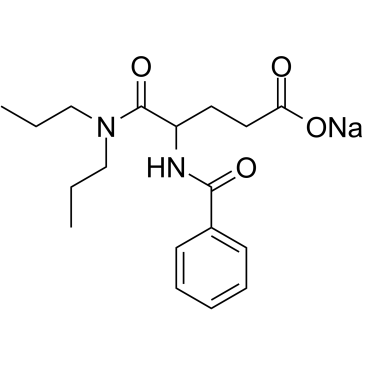Proglumide sodium salt

Proglumide sodium salt structure
|
Common Name | Proglumide sodium salt | ||
|---|---|---|---|---|
| CAS Number | 99247-33-3 | Molecular Weight | 356.39200 | |
| Density | N/A | Boiling Point | N/A | |
| Molecular Formula | C18H25N2NaO4 | Melting Point | N/A | |
| MSDS | USA | Flash Point | N/A | |
|
Flavonoids from Sideritis Species: Human Monoamine Oxidase (hMAO) Inhibitory Activities, Molecular Docking Studies and Crystal Structure of Xanthomicrol.
Molecules 20 , 7454-73, (2015) The inhibitory effects of flavonoids on monoamine oxidases (MAOs) have attracted great interest since alterations in monoaminergic transmission are reported to be related to neurodegenerative diseases such as Parkinson's and Alzheimer's diseases and psychiatr... |
|
|
Inhibition of LSD1 reduces herpesvirus infection, shedding, and recurrence by promoting epigenetic suppression of viral genomes.
Sci. Transl. Med. 6(265) , 265ra169, (2014) Herpesviruses are highly prevalent and maintain lifelong latent reservoirs, thus posing challenges to the control of herpetic disease despite the availability of antiviral pharmaceuticals that target viral DNA replication. The initiation of herpes simplex vir... |
|
|
Selective monoamine oxidase B inhibition by an Aphanizomenon flos-aquae extract and by its constitutive active principles phycocyanin and mycosporine-like amino acids.
Phytomedicine 21(7) , 992-7, (2014) Aphanizomenon flos-aquae (AFA) is a fresh water unicellular blue-green alga that has been traditionally used for over 25 years for its health-enhancing properties. Recent studies have shown the ability of a proprietary AFA extract (Klamin(®)) to improve mood,... |
|
|
Cholecystokinin actions in the parabrachial nucleus: effects on thirst and salt appetite.
Am. J. Physiol. 5 , R1431-R1437, (1998) The present study investigated the effects of bilateral injections of the nonselective CCK receptor antagonist proglumide or CCK-8 into the lateral parabrachial nuclei (LPBN) on the ingestion of 0.3 M NaCl and water induced by intracerebroventricular injectio... |
|
|
The effect of centrally administered CCK-receptor antagonists on food intake in rats.
Physiol. Behav. 61 , 823-827, (1997) Cholecystokinin (CCK) receptors are classified as two subtypes, designated CCK(A) and CCK(B), and both subtypes are found in brain and peripheral tissues of rats. CCK-8 has been shown to act peripherally to reduce meal size, and this satiating action can be b... |